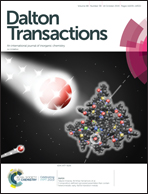Bioinspired models for an unusual 3-histidine motif of diketone dioxygenase enzyme†
Abstract
Bioinspired models for contrasting the electronic nature of neutral tris-histidine with the anionic 2-histidine-1-carboxylate facial motif and their subsequent impact on catalysis are reported. Herewith, iron(II) complexes [Fe(L)(CH3CN)3](SO3CF3)21–3 of tris(2-pyridyl)-based ligands (L) have been synthesized and characterized as accurate structural models for the neutral 3-histidine triad of the enzyme diketone dioxygenase (DKDO). The molecular structure of one of the complexes exhibits octahedral coordination geometry and Fe–N11py bond lengths [1.952(4) to 1.959(4) Å] close to the Fe–NHis bond distances (1.98 Å) of the 3-His triad in the resting state of the enzyme, as obtained by EXAFS studies. The diketonate substrate-adduct complexes [Fe(L)(acacR)](SO3CF3) (R = Me, Ph) of 1–3 have been obtained using Na(acacR) in acetonitrile. The Fe2+/3+ redox potentials of the complexes (1.05 to 1.2 V vs. Fc/Fc+) and their substrate adducts (1.02 to 1.19 V vs. Fc/Fc+) appeared at almost the same redox barrier. All diketonate adducts exhibit two Fe(II) → acac MLCT bands around 338 to 348 and 430 to 490 nm. Exposure of these adducts to O2 results in the decay of both MLCT bands with a rate of (kO2) 5.37 to 9.41 × 10−3 M−1 s−1. The kO2 values were concomitantly accelerated 20 to 50 fold by the addition of H+ (acetic acid), which nicely models the rate enhancement in the enzyme kinetics by the glutamate residue (Glu98). The oxygenation of the phenyl-substituted adducts yielded benzoin and benzoic acid (40% to 71%) as cleavage products in the presence of H+ ions. Isotope-labeling experiments using 18O2 showed 47% incorporation of 18O in benzoic acid, which reveals that the oxygen originates from dioxygen. Thus, the present model complexes exhibit very similar chemical surroundings to the active site of DKDO and mimic its functions elegantly. On the basis of these results, the C–C bond cleavage reaction mechanism is discussed.



 Please wait while we load your content...
Please wait while we load your content...